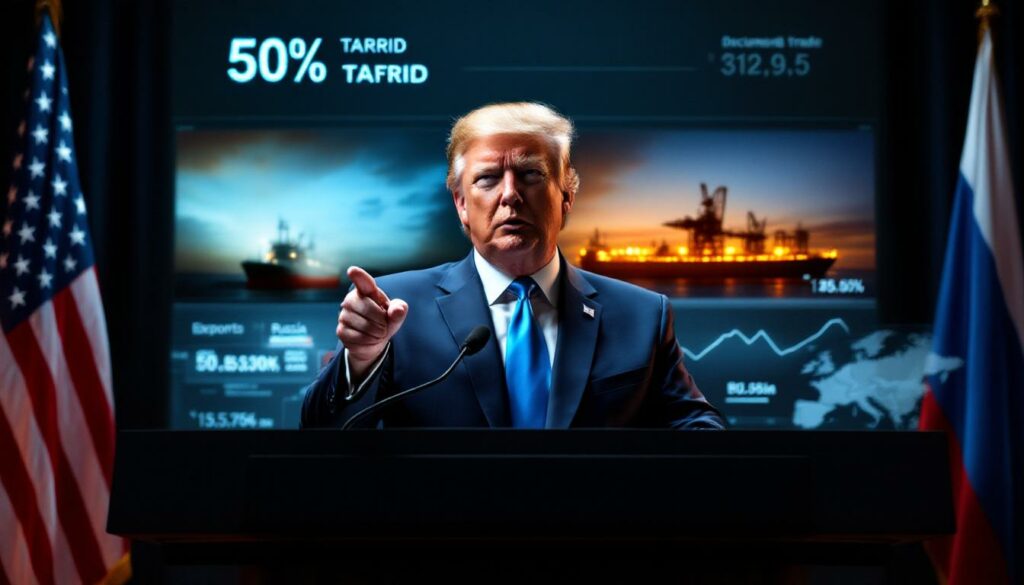Trump's Bold Move: 50% Tariffs on Indian Imports Over Russian Oil Purchases
In a dramatic escalation of trade tensions, President Trump has announced sweeping 50% tariffs on Indian imports to the United States, citing India's continued purchases of Russian oil as the primary justification. This development marks one of the most aggressive trade actions against India in recent history, with far-reaching implications for global trade, energy markets, and geopolitical relationships.
What Are the New Tariffs Announced by Trump?
Details of the 50% Tariff Announcement
The newly announced 50% tariff would apply broadly to Indian imports entering the U.S. market, potentially affecting goods worth billions of dollars annually. The bilateral trade between the United States and India reached approximately $190 billion in 2023, with India exporting around $83 billion in goods and services to American markets.
This tariff rate represents a significant escalation compared to typical tariff levels, which generally range from 2-5% for most products under normal trade relations. The magnitude of this action underscores the administration's determination to influence India's energy procurement decisions through U.S. economy tariffs.
Timeline and Implementation Schedule
While the announcement has been made, specific implementation details remain somewhat unclear. Based on previous tariff actions, industry analysts expect a notice period of 30-60 days before full implementation, providing businesses with a limited window to adjust supply chains and inventory management.
The tariffs would likely be implemented through presidential proclamation under Section 232 of the Trade Expansion Act or Section 301 of the Trade Act, both of which grant the president broad authority to impose tariffs for national security or unfair trade practice concerns.
Why Is Trump Targeting India's Russian Oil Purchases?
Strategic Reasoning Behind the Tariffs
The primary motivation appears to be economic pressure designed to disrupt India's energy relationship with Russia. Since Western sanctions on Russian energy exports began, India has dramatically increased its Russian oil imports, effectively providing Russia with continued revenue streams despite international efforts to isolate the Russian economy.
From the U.S. perspective, these oil purchases represent a significant undermining of Western sanctions policy. By imposing substantial tariffs impact markets, the administration aims to create economic consequences that outweigh the benefits India receives from discounted Russian energy.
Previous Warnings and Escalation Path
This announcement follows a pattern of escalating rhetoric. Just days earlier, Trump had threatened "major tariff hikes" on Indian goods over the same issue, indicating a rapid intensification of trade tensions. The short timeframe between warning and action suggests limited diplomatic efforts to resolve the issue through negotiation before resorting to punitive measures.
The progression from threats to announced implementation within days represents a characteristic approach that prioritizes leveraging economic pressure rather than extended diplomatic dialogue.
How Significant Is India's Russian Oil Trade?
Volume and Value of India's Russian Oil Imports
India's imports of Russian crude have increased approximately tenfold since 2022, making India one of Russia's most important oil customers globally. Before 2022, India imported relatively modest amounts of Russian crude, but this figure has grown to approximately 1.7-2 million barrels per day in recent months.
Indian refiners have been purchasing Russian crude at substantial discounts, often $10-15 per barrel below international benchmark prices. This price advantage translates to savings of roughly $5-7 billion annually for the Indian economy, creating a strong economic incentive to maintain these purchases despite international pressure.
India's Position on Russian Oil Purchases
Indian officials have consistently defended their approach as pragmatic economic policy rather than political alignment. With over 85% of its oil needs met through imports, India has maintained that energy security and affordability are non-negotiable priorities for its developing economy.
India's External Affairs Minister has repeatedly stated that the country's first responsibility is to its own citizens and economic development, emphasizing that India's purchases remain compliant with international sanctions as they apply specifically to India. This stance reflects India's longstanding policy of strategic autonomy in foreign relations.
What Economic Impact Will These Tariffs Have?
Potential Effects on Indian Exports
The proposed 50% tariffs would significantly undermine the competitiveness of Indian goods in the U.S. market. Key export sectors at risk include:
- Pharmaceuticals ($7.4 billion annually)
- Textiles and apparel ($8.2 billion annually)
- Jewelry and precious stones ($5.8 billion annually)
- Information technology services ($14.3 billion annually)
- Machinery and mechanical appliances ($3.7 billion annually)
Many of these industries operate on profit margins of 10-15%, making it mathematically impossible to absorb a 50% tariff without substantial price increases or market abandonment.
Broader Economic Consequences
Beyond direct export impacts, secondary effects could include:
- Currency volatility for the Indian rupee, potentially triggering capital outflows
- Disruption of global supply chains that incorporate Indian manufacturing
- Reconsideration of planned U.S. direct investments in Indian manufacturing
- Potential knock-on effects for India's broader trade relationships
Economic analysts estimate that a fully implemented 50% tariff could reduce India's GDP growth by 0.3-0.5 percentage points in the following year, representing billions in lost economic activity.
How Does This Fit Into Trump's Broader Trade Strategy?
Comparison to Other Trump-Era Trade Actions
The 50% tariff rate exceeds most previous Trump administration tariff actions, which typically ranged from 10-25% for most countries. For comparison:
| Country | Previous Trump-Era Tariffs | Products Affected |
|---|---|---|
| China | 25% (Section 301) | $370 billion in goods |
| EU | 25% (Section 232) | Steel and aluminum |
| Canada | 10-25% (Section 232) | Steel and aluminum |
| Mexico | 10-25% (Section 232) | Steel and aluminum |
| India | 50% (New announcement) | Potentially all imports |
This escalation signals a more aggressive approach to using tariffs as leverage in international relations, particularly regarding energy geopolitics.
Potential Negotiation Strategy
Historical patterns suggest this high initial tariff rate may function as an opening position rather than a final policy. Previous Trump-era trade actions often followed a pattern of:
- Announcement of substantial tariffs
- Market disruption and business uncertainty
- Bilateral negotiations under economic pressure
- Modified agreements that address specific U.S. concerns
- Partial reduction or recalibration of tariffs
This approach leverages economic uncertainty as negotiating capital, creating incentives for rapid resolution on terms favorable to U.S. interests.
What Are the Geopolitical Implications?
Impact on U.S.-India Strategic Partnership
This tariff announcement creates significant tension in the U.S.-India relationship at a time when many strategic analysts had viewed closer ties between the two democracies as crucial to a balanced Indo-Pacific strategy. Areas potentially affected include:
- Military cooperation and defense technology transfers
- Cybersecurity partnerships and intelligence sharing
- Diplomatic alignment on regional security concerns
- Technology partnerships in critical sectors
"The timing of this action is particularly challenging as both countries had been working to strengthen their strategic partnership to balance China's influence in Asia. Economic disputes of this magnitude inevitably spill over into broader security relationships." – Former U.S. Ambassador to India
Global Energy Market Implications
The move signals a more assertive U.S. approach to enforcing its preferences regarding global energy trade flows. This has several implications:
- Other Russian oil purchasers may face increased scrutiny
- Global energy trade patterns could realign along geopolitical lines
- Energy security considerations may increasingly trump market efficiency
- Price differentials between sanctioned and non-sanctioned oil could widen
Energy security experts note that this represents a significant escalation in the weaponization of energy trade policy, potentially fragmenting global energy markets along political lines rather than economic efficiency.
How Might India Respond to These Tariffs?
Potential Retaliatory Measures
India has several options for responding to these tariffs:
-
Counter-tariffs on U.S. goods: India previously imposed retaliatory tariffs on 28 U.S. products in 2019 in response to steel and aluminum tariffs. Similar measures could target U.S. agricultural exports, particularly almonds, apples, and pulses.
-
WTO dispute resolution: Filing formal complaints through international trade governance structures, though these processes typically take years to resolve.
-
Strategic sector targeting: India could impose regulatory hurdles or market access restrictions in sectors where U.S. companies are particularly dependent on Indian markets, such as technology services or pharmaceutical manufacturing.
-
Currency policy adjustments: Allowing greater depreciation of the rupee to partially offset tariff impacts for exporters.
Diplomatic and Negotiation Avenues
Indian officials will likely pursue multilateral diplomatic channels while simultaneously preparing retaliatory options. Possible negotiation approaches include:
- Proposing a gradual reduction schedule for Russian oil imports
- Offering increased purchases of U.S. energy products as alternatives
- Accelerating resolution of existing trade disputes in areas like intellectual property
- Leveraging India's growing importance in technology supply chains and rare earth minerals
India's significant economic relationship with the U.S. creates mutual incentives to find a negotiated solution, though domestic political considerations in both countries may complicate rapid resolution.
What Does This Mean for Global Oil Markets?
Potential Shifts in Global Oil Trade Patterns
If India reduces its Russian oil purchases in response to U.S. pressure, several market realignments could occur:
- Russia would need to find alternative buyers, likely offering even deeper discounts to countries less concerned about U.S. reactions
- India would need to secure replacement supplies from Middle Eastern producers, potentially driving up premium crude prices
- China might increase its own Russian oil imports to capitalize on deeper discounts
- Overall global oil trading efficiency would likely decrease as political considerations override market optimization
These shifts could create temporary regional supply imbalances as trade flows readjust, potentially causing oil price movements in specific crude grades.
Price Implications for Global Oil Benchmarks
The uncertainty created by this trade action could contribute to oil price volatility in the near term. Current WTI crude prices stand at $65.54 per barrel, while Brent crude trades at $68.08. Several potential price impacts include:
- Short-term volatility: Markets typically react to geopolitical uncertainty with price spikes
- Medium-term premium for non-Russian crudes: If India shifts purchases to alternative suppliers
- Wider Brent-Urals spread: The discount for Russian oil could increase further if India reduces purchases
- Regional price differentials: Asian refiners may see different pricing dynamics than European counterparts
Energy economists note that artificially redirecting trade flows typically increases overall system costs, potentially raising global average oil prices by $1-3 per barrel during the adjustment period.
How Are Other Countries Reacting?
Responses from Key International Players
Other major economies are monitoring this development carefully, particularly those with significant trade relationships with both the U.S. and India:
- European Union: Concerned about fragmentation of global trade rules but broadly supportive of pressure on Russian energy exports
- Japan: Navigating competing interests as a U.S. security ally but also an energy importer with supply diversification needs
- Gulf oil producers: Potentially benefiting from increased Indian purchases if Russian imports decline
- Australia: Cautiously supportive of the approach while concerned about broader implications for rules-based trade
Many countries face the dilemma of balancing strategic alignment with the U.S. against their own economic and energy security interests, according to recent reporting by The Guardian.
China's Perspective and Potential Response
China's position is particularly complex as it balances multiple strategic considerations:
- As another major buyer of Russian oil, China may fear similar pressure tactics
- Chinese policymakers may see opportunity to deepen economic ties with India if U.S.-India relations deteriorate
- The situation potentially offers China increased leverage in its own energy relationship with Russia
- Beijing may view the situation as further evidence of U.S. willingness to weaponize economic relationships
Chinese state media has already characterized the tariff threats as "economic coercion" and suggested they demonstrate the unreliability of the U.S. as a trading partner, messaging that aligns with broader Chinese diplomatic narratives amid the ongoing U.S.-China trade war.
What Are the Implications for U.S. Businesses and Consumers?
Impact on U.S. Companies with Indian Supply Chains
U.S. businesses across multiple sectors would face disruption from these tariffs:
- Pharmaceuticals: 40% of generic drugs in the U.S. contain ingredients manufactured in India
- Information technology: Many U.S. tech companies rely on Indian development teams and services
- Textiles and apparel: Retail supply chains often incorporate Indian manufacturing
- Automotive components: Increasingly integrated into global supply chains
Companies would face difficult decisions about absorbing costs, raising prices, or attempting to rapidly shift supply chains to alternative countries—each option carrying significant business challenges.
Potential Consumer Price Effects
American consumers could see price increases across various product categories:
- Prescription medications: Particularly generic drugs, which could see 10-15% price increases
- Clothing and textiles: Retail prices could rise 5-10% for affected categories
- Jewelry and accessories: Potential increases of 15-25% for Indian-manufactured items
- Food products: Selected imports including rice, spices, and specialty foods
The impact would vary significantly by product category depending on the availability of substitute suppliers and the elasticity of consumer demand, as Politico reports.
Disclaimer: The economic forecasts presented in this article represent estimates based on similar historical situations and economic modeling. Actual market impacts may vary significantly depending on implementation details, diplomatic developments, and broader economic conditions.
FAQ: Understanding the U.S.-India Tariff Situation
Will these tariffs definitely go into effect?
While the announcement indicates serious intent, there remains significant possibility for negotiation before implementation. Historical patterns suggest a negotiation window during which both sides will attempt to find compromise positions. The unusually high 50% rate may indicate an opening position rather than a final policy.
How does this compare to Trump's tariffs on Chinese goods?
The 50% rate significantly exceeds most of the tariffs imposed on Chinese goods during Trump's previous administration, which generally ranged from 10-25%, though some specific products faced higher rates. This suggests an even more aggressive approach to trade leverage with India than was applied to China.
Could this lead to broader trade tensions between the U.S. and India?
Yes, there is significant risk of escalation if India responds with counter-tariffs or other trade restrictions. Previous trade disputes between the countries have typically remained contained to specific sectors, but the broad nature and high rate of these proposed tariffs create potential for wider economic conflict affecting multiple industries.
What options does India have to address U.S. concerns without abandoning Russian oil?
India could propose several compromise approaches:
- A gradual reduction schedule for Russian oil imports
- Increased energy imports from the U.S. or U.S. allies
- Enhanced cooperation on other strategic priorities like the Russian uranium import ban
- Commitments to maintain Russian purchases below certain thresholds
- Joint investment in alternative energy development
Any workable solution would need to balance India's energy security and economic needs with U.S. strategic objectives regarding Russia.
Global Energy Market Considerations
The situation highlights the increasing intersection between geopolitics and energy markets. As countries increasingly view energy trade through a strategic rather than purely economic lens, market participants must adjust to a new reality where political risk factors more heavily into energy investment and procurement decisions.
For energy market participants, the key considerations include:
- Higher compliance and regulatory risks in international energy trading
- Increased importance of political risk assessment in energy procurement
- Growing premium for supply diversity and flexibility
- Potential long-term segmentation of global energy markets along political lines
These developments suggest a more complex future for global energy markets where price is increasingly just one of many factors determining trade flows.
Ready to Stay Ahead of Major Mineral Discoveries?
Gain immediate notifications of significant ASX mineral discoveries with Discovery Alert's proprietary Discovery IQ model, transforming complex mineral data into actionable investment insights. Explore why historic discoveries can generate substantial returns by visiting Discovery Alert's dedicated discoveries page and begin your 30-day free trial today to position yourself ahead of the market.




